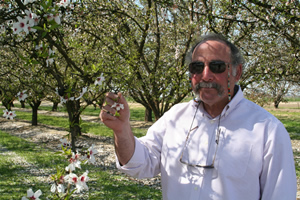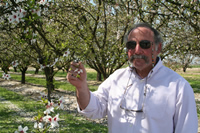UC scientist: Less water makes more cents
-
March 20, 2009
-
-
CONTACT: Jeannette Warnert
-
(559) 646-6074
-
jewarnert@ucdavis.edu
-
-
N / A
-
 David Goldhamer (See end of release for hi-res version.)
David Goldhamer (See end of release for hi-res version.)When UC Cooperative Extension irrigation specialist David Goldhamer began toying with the concept of deficit irrigation in the early 1980s, even he never imagined the potential.
Traditionally in irrigated agriculture, farmers want to give crops all the water they can drink. Goldhamer’s three decades of research has shown that knowing when to withhold water from tree crops and when to quench the crops’ thirst are very powerful tools for dealing with drought, plant disease and fruit quality.Goldhamer’s focus on deficit irrigation continues uninterrupted even as California experiences ebbs and flows in annual rain and snow. Public interest slows when water is abundant, but since California Governor Arnold Schwarzenegger declared the state in a drought emergency in February, it is again rising to a crescendo.Goldhamer’s office at the UC Kearney Research and Extension Center near Parlier has all the trappings of a long career in scientific research. The walls are concealed by bookshelves overloaded with irrigation literature. Mementos, conference proceedings, research papers and reference books share space with an old box of Corn Flakes, dusty cans of tuna and aseptic fruit cups, remnants of a short-lived effort to eat healthier.Video clips with UC Davis Cooperative Extension
water management specialist David A. Goldhamer
on regulated deficit irrigation.A half-full container of Tootsie Rolls sits on the desk. “I can’t remember how or why they arrived,” he said. But there is definite purpose behind a model of the Wright Brothers’ airplane that sits next to two oversized Apple computer monitors.“The Wright Brothers’ first airplane flight was in 1903. In 1969, astronauts landed on the moon,” he said. “In just 66 years – six and a half decades – science advanced that much. It gives me motivation to do my work.”Goldhamer knows he could never hope to make such rapid progress in irrigation science – if for no other reason than the lack of the copious research funding made available to the U.S. space program. But agricultural science made a significant leap when Goldhamer began conducting deficit irrigation research projects with UC Cooperative Extension farm advisors early in his career.“Very little was known about almond irrigation at the time,” Goldhamer said. “During the 1977-79 drought, farmers had to make irrigation cutbacks, but nobody knew when was the best time to stress almond trees, for example.”Deficit irrigation first appeared in scientific literature detailing the work of Australian researcher David Chalmers, who met with success when he cut back the water allotment for peach trees to reduce vigorous vegetative growth. Water cutbacks led to better quality fruit.Two major discoveriesGoldhamer said he and now-retired Kern County farm advisor Mario Viveros began setting up research projects on Kern County farms to test Chalmers’ methods and answer basic questions about local almond irrigation scheduling. It was common for farmers to neglect irrigating almonds after harvest, so as an aside, the scientists also compared irrigation regimes carried out after harvesting the trees.“We found that post-harvest irrigation was critical for sustained yields,” he said. “At that time, you would commonly see almond orchards defoliate right after harvest. Not anymore. This research fundamentally changed how we irrigate almonds in the southern San Joaquin Valley. This finding was a big revelation to us as well as the growers.”The research also produced another surprising result. Beth Teviotdale, a now-retired plant pathologist who was working with Goldhamer’s group, observed changes in the amount of hull rot that occurred under various irrigation regimes.“We found that if the trees experience water stress during the first two weeks in July, the occurrence of hull rot is significantly reduced with little or no reduction in almond yield,” he said. “Some scientists end their careers having never been involved in a discovery that significantly changes grower practices for the better. During the first 10 years of my tenure, I had the pleasure of being part of two.”Solving problems and advancing scienceGoldhamer was raised in Upland, a Los Angeles suburb at the base of the San Gabriel Mountains. Aiming to find a career working outdoors, he enrolled at UC Davis as a soil and water science major. After earning a bachelor’s degree, he started an assistantship with soil physicist Don Nielson and eventually earned master’s and doctorate degrees in the same academic discipline as the professor.Still, Goldhamer was intent on doing applied agricultural research rather than the more basic science conducted by soil physicists. Rather than accepting lucrative job offers in environmental engineering, he took a job with a fertilizer company and worked for a year with growers in Bakersfield. When he was offered his UC extension position in 1980, initially he turned it down.“I was terrified of public speaking,” Goldhamer said. “I couldn’t deal with the thought of having to give a 30-minute talk.”After reconsidering for about an hour, Goldhamer called back and accepted the job.“I still have trouble giving a 30-minute talk,” Goldhamer said. “However, now it’s because I’ve gotten very comfortable giving presentations and have developed so much information, I need more time.”Goldhamer said his approach to the job was influenced by Elias Fereres, a specialist based at UC Davis who had been trained as both an irrigation engineer in Spain and as a plant physiologist in the United States.“He was doing great research and publishing the results in peer reviewed journals,” Goldhamer said. “He cared not only about solving applied problems but also about the science of the solutions. I patterned my career after his.”Fereres eventually moved back to Spain and he and Goldhamer continue to collaborate on projects, including a detailed deficit irrigation overview that will soon be published by the United Nations Food and Agriculture Organization.Reducing water, increasing valueEarly in his career, Goldhamer reflected on the irrigation research needs he could foresee in the coming 10 to 20 years. He recognized that research on irrigation systems – furrow, sprinkler, drip and micro-sprinklers – had already been done and there was little need to devote additional research that would likely lead to small advancements with these technologies. Even though he was trained as a soil physicist, he recognized that the plant needed to be the focus of applied water management research. It was during the California drought of 1987 to 1992 that Goldhamer realized the potential of regulated deficit irrigation (RDI) for reducing the consumptive use of water while maximizing yields and for keeping trees alive in times when water is scarce.Decades of research with field and row crops had established that there was a one-to-one relationship between water use and yields.“With these crops, if you reduced water use by 25 percent, you could expect a 25 percent reduction in yield,” Goldhamer said. “This is what we were taught in school and it was the basis for scientific irrigation scheduling that we were teaching growers -- irrigate to keep pace with evapotranspiration.”However, Goldhamer’s research with tree crops was confounding this conventional wisdom. He was reducing irrigation without reducing yields. In some cases, he found that RDI could not only reduce consumptive use, but also improve fruit quality and increase grower profit. For the next 20 years, he conducted extensive work on a wide variety of fruit and nut trees to pin down how much water can be saved, and when it can be withheld and still have no impacts or even a positive impact on crop yield. Other benefits for deficit irrigation were also sought.For example, the orange variety “frost nucellar” was susceptible to peel creasing, which reduced the fruit’s grade from fancy to choice or, in severe cases, to juice, which slashes farmers’ profit. Studying literature, Goldhamer learned that creasing is attributed to rapid fruit growth early in the season. Deficit irrigation, he reasoned, could slow development of fissures between the peel and pulp that caused the unsightly creasing. Research determined that early-season water stress results in a two-thirds reduction in the problem. Goldhamer achieved what he considers to be “the holy grail” of RDI: decreasing water use while increasing crop revenue.“This research is cultivar dependent – on other cultivars, the early-season water stress doesn’t improve crop value,” Goldhamer said. “For example, with late harvest varieties, such as ‘Lane Late,’ a late season or season-long water stress is best. Surprisingly, we found that we could reduce water use by 20 to 50 percent and almost double crop value by improving the fruit size distribution toward more valuable sizes.”Recent news reports of farmers bulldozing or stumping mature trees early in the 2009 drought puzzles Goldhamer. Even a small amount of water, if applied at the right time, he said, permits tree survival in water-lean years.In fact, pistachios, he has found, are especially drought-resistant. Working on the west side of the San Joaquin Valley near Kettleman City, he deprived mature pistachio trees of all irrigation water during a four-year drought. Even though they received only three inches of rainwater per year, they didn’t die.In another study, almond trees that were fully irrigated with 16 inches of water early in the season and then cut off completely suffered fatal damage. However, Goldhamer believes that 8 to 10 inches of water applied at just the right time during the season would have kept those trees alive. This points to the importance of RDI timing.“Farmers can take the information we’ve developed over the years to make informed decisions about how to apply a limited water supply,” Goldhamer said.To inform growers facing dramatic water cutbacks in the 2009 season, Goldhamer has scoured publications on almond deficit irrigation and summarized many unpublished studies he has done, for example, on stumping and antitranspirants (antitranspirants are products that can be sprayed on trees to reduce the loss of moisture from leaves).He will share his career-long accumulation of research knowledge during the Drought Irrigation Management for Almonds meeting, 7:30 a.m. - 12:30 p.m., Tuesday, March 31, 2009, at the Panoche Creek Packing, 1221 South Madera Ave., Kerman, Calif. Additional presentations at the event will be:- Fine tuning your micro-irrigation system, by UC Davis irrigation specialist Larry Schwankl
- Kaolin-processed clay’s effects on almond bud failure and yield, by UCCE Madera County farm advisor Brent Holtz
- Use of reflective particle films to increase water use efficiency, by USDA Agricultural Research Service scientist Michael Glenn
- Irrigating almonds with groundwater, by UCCE Fresno County farm advisor Dan Munk
- Acute drought impacts on groundwater basins, by UC Davis groundwater hydrologist Thomas Harter
For more information about the March 31 meeting, call (559) 449-1721.
Media contact: David Goldhamer, dagoldhamer@ucdavis.edu, (559) 646-6575
 Click for high-resolution version.
Click for high-resolution version.

